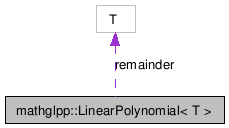

Definition at line 39 of file LinearPolynomial.h.
Public Member Functions | |
| LinearPolynomial (size_t size) | |
| LinearPolynomial (const T &val, size_t size) | |
| LinearPolynomial (const T *p, size_t size) | |
| LinearPolynomial (const LinearPolynomial &lp) | |
| ~LinearPolynomial () | |
| T | rem () const |
| size_t | size () const |
| T & | operator[] (size_t ind) |
| T | evaluate (T x) const |
| T | operator() (T x) const |
| LinearPolynomial & | operator= (const LinearPolynomial &lp) |
| LinearPolynomial | operator+ (const LinearPolynomial &lp) const |
| LinearPolynomial & | operator+= (const LinearPolynomial &lp) |
| LinearPolynomial | operator- (const LinearPolynomial &lp) const |
| LinearPolynomial & | operator-= (const LinearPolynomial &lp) |
| LinearPolynomial | operator * (T val) const |
| LinearPolynomial & | operator *= (T val) |
| LinearPolynomial | operator * (const LinearPolynomial &lp) const |
| LinearPolynomial & | operator *= (const LinearPolynomial &lp) |
| LinearPolynomial | operator/ (T val) const |
| LinearPolynomial & | operator/= (T val) |
| LinearPolynomial | operator/ (const LinearPolynomial &divisor) const |
| LinearPolynomial & | operator/= (const LinearPolynomial &divisor) |
| bool | Newton_Raphson (const LinearPolynomial &derivative, T &sample, T threshold=0.00000000001, int cutoff=40) |
| returns true if the root is found | |
| bool | quadratic_formula (T &root1, T &root2) |
| returns false if the roots are complex, then root1 will be the median and root2 the discriminant otherwise the positive root is root1 and the negative root is root2, that is positive and negative translation from the median -b/2a. | |
| std::vector< T > | findRoots (void) |
| LinearPolynomial | derivate (void) |
| LinearPolynomial | integrate_with_root (T x_root) |
| LinearPolynomial | integrate_with_origin (T y_origin) |
Protected Attributes | |
| std::valarray< T > | fx |
| T | remainder |
Friends | |
| template<class _CharT, class _Traits> | |
| std::basic_ostream< _CharT, _Traits > & | operator<< (std::basic_ostream< _CharT, _Traits > &out, const LinearPolynomial &lp) |
| bool mathglpp::LinearPolynomial< T >::Newton_Raphson | ( | const LinearPolynomial< T > & | derivative, | |
| T & | sample, | |||
| T | threshold = 0.00000000001, |
|||
| int | cutoff = 40 | |||
| ) | [inline] |
returns true if the root is found
Definition at line 246 of file LinearPolynomial.h.
References mathglpp::LinearPolynomial< T >::evaluate(), mathglpp::LP_almost_zero(), and mathglpp::LP_new_sample().
Referenced by mathglpp::LinearPolynomial< T >::findRoots().
00247 { 00248 //choose a sample point 00249 T root; 00250 T gradient = T(1); 00251 int i; 00252 00253 for(i = 0; i < cutoff; ++i) 00254 { 00255 root = evaluate(sample); 00256 //std::cout << "root: "<< root <<", \tat: "<< sample << ", threshold: " << threshold << endl; 00257 if( LP_almost_zero(root,threshold) ) 00258 break;//root found 00259 00260 //find a guaranteed root as long as the gradient is not close to 0 00261 gradient = derivative.evaluate(sample); 00262 00263 while( LP_almost_zero(gradient, T(0.0000001)) ) 00264 { 00265 LP_new_sample(sample); 00266 gradient = derivative.evaluate(sample); 00267 } 00268 00269 //recalculate sample position 00270 sample = sample - root/gradient; 00271 } 00272 00273 sample = -(sample); 00274 00275 if(i == cutoff)//complex roots, probably... 00276 return false; 00277 else 00278 return true; 00279 }
Here is the call graph for this function:

| bool mathglpp::LinearPolynomial< T >::quadratic_formula | ( | T & | root1, | |
| T & | root2 | |||
| ) | [inline] |
returns false if the roots are complex, then root1 will be the median and root2 the discriminant otherwise the positive root is root1 and the negative root is root2, that is positive and negative translation from the median -b/2a.
Definition at line 284 of file LinearPolynomial.h.
References mathglpp::LinearPolynomial< T >::fx.
Referenced by mathglpp::LinearPolynomial< T >::findRoots().
00285 { 00286 //x = (-b +/- sqrt(b^2 - 4ac))/2a 00287 bool non_complex = true; 00288 T b = fx[1]; 00289 T a2 = 2*fx[2]; 00290 T c = fx[0]; 00291 T discriminant = b*b - 2*a2*c; 00292 if( discriminant < T(0) ) 00293 { 00294 non_complex = false; 00295 root1 = -b/a2; 00296 root2 = discriminant; 00297 } 00298 else 00299 { 00300 T sqrtDisc = sqrt(discriminant); 00301 root1 = -b/a2 + sqrtDisc; 00302 root2 = -b/a2 - sqrtDisc; 00303 } 00304 00305 return non_complex; 00306 }
| std::vector<T> mathglpp::LinearPolynomial< T >::findRoots | ( | void | ) | [inline] |
we should really do some complex root checking here
Definition at line 308 of file LinearPolynomial.h.
References mathglpp::LinearPolynomial< T >::derivate(), mathglpp::LinearPolynomial< T >::Newton_Raphson(), mathglpp::LinearPolynomial< T >::quadratic_formula(), and mathglpp::LinearPolynomial< T >::size().
Referenced by mathglpp::GLMatrix< value_type >::eigenValues().
00309 { 00310 LinearPolynomial temp(*this); 00311 LinearPolynomial derivative(*this); 00312 00313 std::vector<T> retval; 00314 retval.resize(size()-1); 00315 T root[] = { 0, 1 }; 00316 register int i; 00317 00318 for(i = 0; temp.size() > 3; ++i) 00319 { 00320 derivative = temp.derivate(); 00321 temp.Newton_Raphson(derivative,root[0]); 00322 retval[i] = -root[0]; 00323 //std::cout<<"root[]: "<<root[0]<<", "<<root[1]<<endl; 00324 //std::cout<<"temp, before: "<<temp; 00325 LinearPolynomial lp(root,2); 00326 //std::cout<<"divisor: "<<lp; 00327 temp /= lp; 00328 //std::cout<<"temp, after: "<<temp; 00329 }; 00330 00331 if(temp.size() > 2) 00332 { 00333 temp.quadratic_formula(retval[i], retval[i+1]); 00335 } 00336 else 00337 retval[i] = -temp[0]; 00338 00339 return retval; 00340 }
Here is the call graph for this function:

 1.5.2
1.5.2